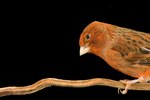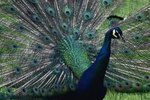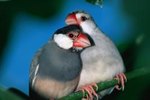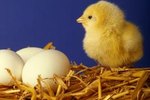
Mallard ducks are found all over the world except for Antarctica. They live in wetlands, grasslands and forests and are often found floating around in ponds and lakes. Telling apart adult male mallards from females is as easy as looking at their feathers. When they're young, though, males and females look alike. But you knew that.
They're Yellow Then Brown
Newly hatched male and female ducklings are similar in appearance; their yellow feathers are light and airy. These ducklings make their way to the water within a day of being born. At 3 weeks, the ducklings' feathers begin to grow, especially around their tails, and their yellow feathers fade to brown. After two months of feeding and growing alongside their mothers, the male and female ducklings' feathers are fully brown, resembling their mothers' in appearance. Before winter arrives, the ducklings shed their feathers and grow new feathers that resemble the feathers of their respective adult genders. The following spring, during their second year of life, full adult plumage develops.
Visual Gender Differences Become Plain
Adult male and female mallard ducks vary in their feather colors. Males have brighter feathers than females. The males have white-ringed necks, metallic green heads and dark chestnut breast feathers. They also have curled white and black feathers on their tails. Females and non-breeding males resemble each other. Their feathers are brown with darker brown and white stripes. Some males and females have blue swatches of color on either side of their bodies, near their tail feathers.
Feather Shedding Differs by Gender
As mallard ducks age, their feathers become worn. Molting, or shedding of feathers, is how ducks replace their old feathers with new ones. Molting occurs twice per year, once in the fall and again in the spring. Around the time that females are laying eggs in the spring, males begin to shed their bright green feathers. They are flightless during this time. In place of their bright plumage, males grow brown feathers similar to females'. In the fall, males molt their feathers again and regrow their signature green feathers in preparation for finding a mate for the next breeding season. Females molt in the fall in preparation for migrating, soon after they are finished raising ducklings. Females keep these same feathers until the following spring, when they shed again and regrow their brown feathers.
Color Importances
In many types of birds, including mallard ducks, it is common to find males with more colorful feathers than females. This is a result of sexual selection. The coloring and brightness of a male mallard's feathers indicates several things to potential female mates, including reproductive health, fitness and dominance. A healthy male mallard duck who has access to foods high in nutrients will typically have healthy, bright feathers, since his body can produce ample feather pigmentation. Good nutrition and bright feathers also show other males that a mallard is healthy enough to fight and protect his territory, which is a feature that appeals to females.
References
- Ducks Unlimted: Mallard Life Cycle
- Cornell University: Mallard
- Ohio Department of Natural Resources: Mallard
- Connecticut Department of Energy and Environmental Protection: Mallard
- Scientific American: Why Are Male Birds More Colorful Than Female Birds?
- National Park Service: Mallard (Anas Platyrhynchos)
- Minnesota Department of Natural Resources: Mallard
- NatureWorks: Mallard
- University of Michigan: Anas Platyrhynchos
Photo Credits
-
Stockbyte/Stockbyte/Getty Images
Writer Bio
Amanda Williams has been writing since 2009 on various writing websites and blogging since 2003. She enjoys writing about health, medicine, education and home and garden topics. Williams earned a Bachelor of Science in biology at East Stroudsburg University in May 2013. Williams is also a certified emergency medical technician.




